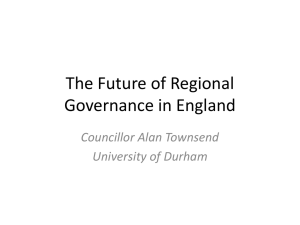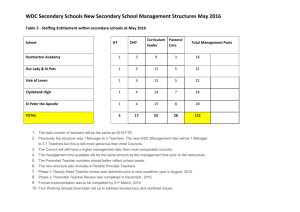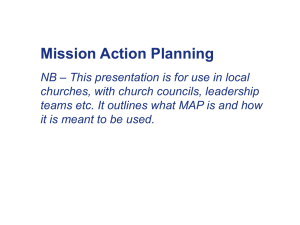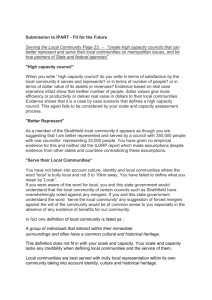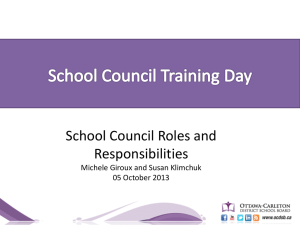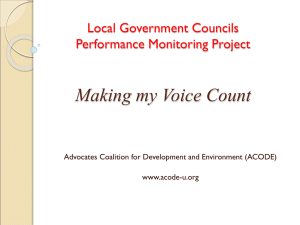Open - The Scottish Government
advertisement
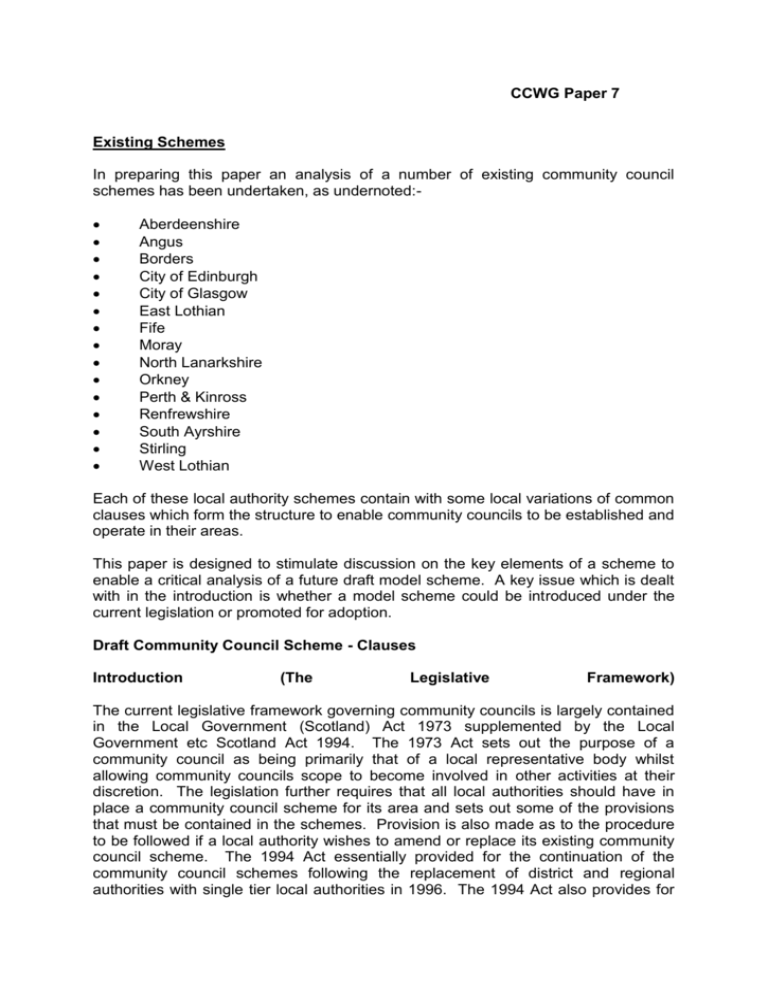
CCWG Paper 7 Existing Schemes In preparing this paper an analysis of a number of existing community council schemes has been undertaken, as undernoted: Aberdeenshire Angus Borders City of Edinburgh City of Glasgow East Lothian Fife Moray North Lanarkshire Orkney Perth & Kinross Renfrewshire South Ayrshire Stirling West Lothian Each of these local authority schemes contain with some local variations of common clauses which form the structure to enable community councils to be established and operate in their areas. This paper is designed to stimulate discussion on the key elements of a scheme to enable a critical analysis of a future draft model scheme. A key issue which is dealt with in the introduction is whether a model scheme could be introduced under the current legislation or promoted for adoption. Draft Community Council Scheme - Clauses Introduction (The Legislative Framework) The current legislative framework governing community councils is largely contained in the Local Government (Scotland) Act 1973 supplemented by the Local Government etc Scotland Act 1994. The 1973 Act sets out the purpose of a community council as being primarily that of a local representative body whilst allowing community councils scope to become involved in other activities at their discretion. The legislation further requires that all local authorities should have in place a community council scheme for its area and sets out some of the provisions that must be contained in the schemes. Provision is also made as to the procedure to be followed if a local authority wishes to amend or replace its existing community council scheme. The 1994 Act essentially provided for the continuation of the community council schemes following the replacement of district and regional authorities with single tier local authorities in 1996. The 1994 Act also provides for each authority to revoke and replace its own scheme which underscores the “individuality” of each scheme. In terms of whether the existing legislation adequately defines the purposes and role of community councils, the 1973 Act states that: in addition to any other purpose which a community council may pursue the general purpose of community councils shall be to ascertain co-ordinate and express the views of the community which it represents in relation to matters for which those authorities are responsible and to take such action in the interests in that community as appears to it to be expedient and necessary. The current legislative requirement is that any amendment to a community council scheme requires to be approved by a meeting of the local authority convened specifically for that purpose. Issues and Questions:- Without primary legislation, it is difficult to envisage how a model scheme, whatever its content, could be “imposed” across all local authorities. However, this issue should be investigated further by the Executive. An alternative would be to have the model scheme adopted through CoSLA and then promoted as best practice. Currently, Section 52(2) of the 1973 Act sets out what must be contained in local authorities' community council schemes:”A map showing the boundaries of the proposed areas of community councils and the boundary of any area where the local authority consider a community council unnecessary: Where a local authority consider a community council unnecessary for any area a statement of reasons; provisions relating to elections or other voting arrangements the composition, meetings, financing and accounts of community councils; and provisions concerning procedures for exchanging information on matters of mutual interest. In addition to this, a community council scheme may contain any other details which a local authority may see fit to include.” Issues and Questions:- The current legislation affords discretion to local authorities in relation to their own community council scheme. Would this be lost of there was a model scheme or would the scheme be intended as the minimum. The current legislation does not specify the level of detail required in a scheme on matters such as meetings, composition or electoral arrangements for community councils. Nor is the scheme required to include any provisions relating to how a community council keeps its own community informed of its business, or the arrangements or the suspension of any community councillor who is considered to have brought the community council into disrepute. Local authorities as administrators of community council schemes, retain the freedom to determine largely for themselves the content and nature of their individual schemes following consultation. The following sections outline the possible matters for inclusion in a national model scheme. Some issues such as community council boundaries are highlighted as these are likely to be sensitive with a range. Role and Responsibilities of Community Councils The key purpose of community councils is to act as a voice for their local area. This will involve them articulating to views and concerns of local people in their area on a wide range of issues of public concern; and make representations to their local authority, other public sector bodies and private agencies on matters within their sphere of interest. It is essential that these views are demonstrated to be accurately representative of the community and, accordingly, the community council have in place recognised consultative mechanisms to validate their views; and devise strategies to secure greater involvement be all sectors of the community. Community councils will be consulted on planning and licensing matters and any other matters deemed appropriate by the local authority and other agencies to consult upon. Community councils may carry out other activities that are in the general interests of the community which they represent, provided these activities fall within the objects of their constitution. Overall, community councils should establish positive working relationships with their local authority and other agencies. In carrying out their activities community councils must at all time adhere to the law. Each community council requires to adopt a standard constitution which has been produced for national use, together with standing orders to encourage and maintain consistency between community councils; and to ensure that their proceedings are properly structured and regulated so that items of business are relative to the community, properly debated and decisions are reached in a democratic manner. (The constitution and other documents would form appendices to the scheme.) Community councils have a duty under statute to represent the views of their local community. It is vital therefore, that they reflect the broad spectrum of opinion and interests of all sections of the community. In order to fulfil their responsibilities as effective and representative, community council shall: Inform the community of the work and decisions of the community council by posting agendas and minutes of meetings in public places, such as libraries and notice boards; and provide contact names, addresses and telephone numbers of community council office bearers. Development of community council web sites is positively encouraged, to enable parties who would otherwise not be able to attend meetings to access the business of the community council. Agendas and minutes of community councils meetings must be presented to their local authority at least 10 days prior to the next meeting date, to enable circulation to relevant elected members, council staff and other parties. Seek to broaden representation/expertise by co-opting individuals/local organisations onto the community council. Make particular efforts to encourage young people/minority groups to attend/participate in community council meetings. Maintain proper financial records and give regular financial reports at community council meetings. A Standard Cashbook has been produced for national use to ensure consistency of financial record-keeping between community councils. Establish a Community Council Forum, comprising all community councils in the local authority area, in consultation with their local authority, to enable discussion of collective issues, exchange of ideas, information and good practice. A standard community council forum constitution has been produced for national use, to ensure consistency between community councils. Liaise closely with their local authority in any change in membership (resignations, co-option, etc). Membership of Community Councils Each community council has a minimum and maximum number of eligible vacancies based upon local population. In areas of sparse population, relative to geographical disposition, such as island or remote communities, special arrangements have been made by these local authorities. The minimum age to stand for election as a community councillor is 16 years. Qualification for membership is by residency. Elected members of the local authority and members of the Scottish, United Kingdom and European Parliaments are not entitled to become ex-officio members of community councils. Issues for Debate o Age o Number of members, proportional per 1,000 population for example (sparsely populated/island communities notwithstanding). o Ex-officio members (eligibility/liability issues) for qualification for electoral/voting purposes. Community Council Boundaries It is a requirement that community council boundaries are identified in a scheme. It is almost universal practice that community council boundaries are recognised in schemes as community/neighbourhood areas which do not mirror electoral wards/other public agency boundaries. Issues for Debate Introducing coterminous community council boundaries with multi-member wards may prove to be a contentious issue as community councils engage and represent immediate local areas and are based and known by their local characteristics and interests. Frequency/Conduct of Elections From the paper which was produced by Renfrewshire Council (and circulated to this Working Group) it can be seen that there is no commonality in frequency/conduct of elections. Issue for Debate Most appropriate electoral methodology (being addressed separately) / frequency of elections. Constitution/Standing Orders There are several examples of Constitutions/Standing Orders across Scotland. To enable uniformity of conduct and business efficacy, a common set of constitutional and standing orders instruments may be required. Issue for Debate How to integrate a common set of instruments to a common community council scheme.



